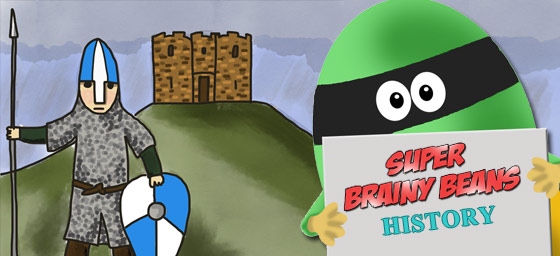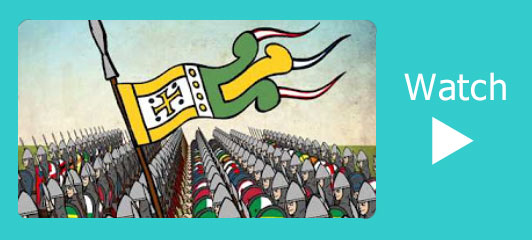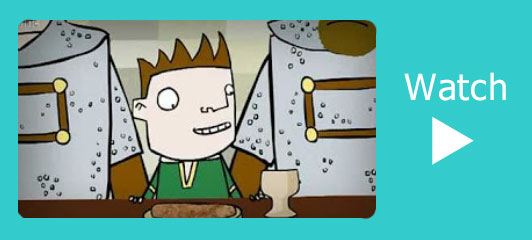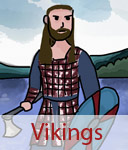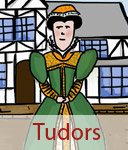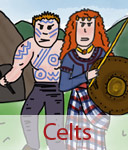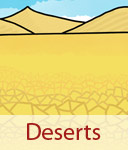The Normans for kids KS2
The Normans for kids learning in KS2 at Primary School. Homework help with the history of Normans, Norman soliders, Norman life.
Time: 1060 - 1200
Who were the Normans?
The Normans were people from Normandy, a region in northern France. Their ancestors were Vikings who had settled there around 150 years earlier. Over time, they learned the French language, became Christians, and built a strong, organised society with towns, churches, and stone castles. They were skilled sailors, clever planners, and brave warriors who loved exploring and conquering new lands.
By 1066, England had a new king, Harold Godwinson, but Duke William of Normandy believed the throne had been promised to him by the previous king, Edward the Confessor. Feeling betrayed, William raised an army of knights and soldiers, gathering ships and supplies to cross the English Channel. This ambitious invasion led to the famous Battle of Hastings, where William fought to claim the English crown and change the course of history.
 BBC Primary History
BBC Primary HistoryThis website covers everything you want to know about the Normans. Norman Castles, celebrations and food.
What was the Battle of Hastings?
The Battle of Hastings took place on 14th October 1066. Duke William of Normandy landed on the south coast of England with thousands of soldiers and knights to claim the English throne from King Harold Godwinson. The battle lasted all day, with both sides fighting fiercely in the fields near Hastings. Harold’s army, made mostly of foot soldiers, held strong at first, forming a shield wall to block the Norman attacks.
The Normans used clever tactics, including fake retreats to trick Harold’s soldiers into breaking their shield wall. Eventually, the Normans broke through, and King Harold was killed, ending Anglo-Saxon rule. William was crowned King of England, taking the title William the Conqueror, and his victory marked the start of Norman rule, changing England’s language, law, and architecture forever.
 The Norman Conquest
The Norman ConquestThe Norman Conquest of England - William the Conqueror.
Motte-and-Bailey Norman castles
After William the Conqueror became king, the Normans needed a way to control the land and protect themselves from uprisings. They quickly built hundreds of motte-and-bailey castles across England.
A motte was a tall, steep mound of earth with a wooden tower on top, giving defenders a high point to spot enemies from far away. The bailey was an enclosed courtyard at the bottom, surrounded by a wooden fence or palisade, where soldiers, animals, and supplies were kept.
These castles were often built near villages or important roads, helping the Normans keep control of the local people. Over time, many of the wooden castles were rebuilt in stone for extra strength, like the Tower of London, which became one of the most famous Norman castles.
Norman life and society
Life in Norman England was very different depending on your social status. At the top were the rich lords and nobles, who lived in large castles or grand houses with thick walls, towers, and moats. They had servants to cook, clean, and care for their families, and they enjoyed hunting, feasting, and fancy clothes made from expensive fabrics.
Most people, however, were peasants or serfs, who worked long hours on the land. They farmed crops, tended animals, and had to give a portion of their harvest to the local lord. Their homes were small, made from wood or wattle and daub, with thatched roofs and dirt floors.
The Normans brought many changes to England. They introduced new foods, such as richer breads and cheeses, and improved farming techniques, like better ploughs and crop rotation. They also introduced French words and customs, which mixed with Old English to create the basis of the English language we speak today.
The feudal system
After becoming king, William introduced the feudal system to organise England and make sure everyone knew their place. The system was like a pyramid:
- At the top was the king, who owned all the land in the country.
- The king gave large pieces of land to barons (powerful nobles) in return for their loyalty and promise to fight for him if England was attacked.
- The barons then gave smaller areas of land to knights, who promised to protect the land and fight for their lord.
- At the bottom were the peasants, also called serfs. They worked hard on the land, growing crops and looking after animals to provide food for everyone.
Everyone had a job and a duty, and life was very strict. Peasants had very little freedom, while barons and knights had power and wealth. This system helped William control the country and keep order.
Norman knights and warfare
Norman knights were some of the most skilled fighters in Europe. They trained from a young age to fight on horseback, wearing heavy chainmail armour and carrying large teardrop-shaped shields. Their main weapons were swords, lances, and bows, which they used to attack both from a distance and up close.
Norman knights were not just strong; they were also clever in battle. They used tricky tactics, like pretending to flee, to lure the enemy into breaking their lines, then turned back to fight. These strategies were very effective and helped the Normans win the Battle of Hastings and take control of England.
The Domesday Book
In 1085, William the Conqueror wanted to know everything about his new kingdom. He ordered a huge survey of all of England. His men went from village to village, asking questions about who owned the land, how many animals and crops they had, and how much their property was worth.
All this information was written down in a massive record called the Domesday Book. It was used to collect taxes and to make sure William could control the country. The book was so detailed that the king could see almost everything about his people and their property.
Norman churches and cathedrals
After the Normans took over England, they built huge stone churches and cathedrals. These were very different from the small wooden churches the Anglo-Saxons had. Norman buildings had thick walls, tall towers, and rounded arches, a style called Romanesque.
These buildings were not just for praying—they also showed that the Normans were powerful and rich. People could see from far away that the Normans were in charge. Famous Norman churches still standing today include Durham Cathedral, Ely Cathedral, and parts of Canterbury Cathedral.
The Bayeux Tapestry
The Bayeux Tapestry is a long, embroidered cloth that tells the story of the Norman invasion of England in 1066. It is almost 70 metres long and is filled with pictures that show key events, such as Harold’s oath to William, the building of Norman ships, and the Battle of Hastings.
Even though it is called a “tapestry,” it is actually stitched with colourful wool onto linen. The pictures show people, horses, ships, and even weapons in amazing detail. The tapestry was made so people could understand the story without being able to read.
What happened to the Normans?
After William the Conqueror and his sons ruled England, the Normans slowly blended with the Anglo-Saxons. They married local people, shared customs, and learned each other’s language. Over time, Normans and Anglo-Saxons became one people, and by the 1200s, no one really thought of the Normans as a separate group anymore.
Even though they merged with the locals, the Normans left a big mark on England. They built castles and cathedrals that still stand today, introduced new laws and the feudal system, and influenced the English language—many words we use now come from Norman French.

